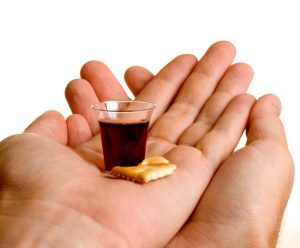 Preparing Visitors for Communion/Eucharist/Lord’s Supper
Preparing Visitors for Communion/Eucharist/Lord’s Supper
Most congregations celebrate Communion/Eucharist/Lord’s Supper in their corporate worship services on a regular basis (weekly, monthly, once a quarter, etc.). While those who attend regularly know what to expect, newcomers do not. As guests are seated and begin to prepare for worship they may note the elements and wonder:
- Is everyone welcome at the table or only those with certain beliefs or membership? Should my children partake?
- Will I need to go forward or do I remain seated?
- Do I partake when I am served or hold each element until I am instructed to partake?
- Is it wine or grape juice (or can I choose between both options)?
- Is the bread gluten free?
- If I am served while seated, what do I do with the empty cup?
- What does this church and/or denomination believe about Communion/Eucharist/Lord’s Supper?
So What?
So far this year, I have been a part of worship in six different congregations when Communion/Eucharist/Lord’s Supper was celebrated. My own experiences illustrate the diversity:
Education/Expectations:
- Written instruction in the bulletin on four occasions
- Verbal instruction during the service on five occasions
- No written or verbal instruction apart from “you may come when you are ready” on one occasion
Experience:
- Remained seated on four occasions
- Stood and went to a designated station on two occasions
Theology:
- Only one congregation provided a written explanation
- No other congregation offered any theological insight beyond the choice of words used at the table or the message of who was welcome
Review your church’s worship bulletin. What words are printed to help prepare newcomers for Communion/Eucharist/Lord’s Supper? Some instructions I found helpful include:
- Please hold the bread and the cup until everyone has been served, that all may partake together.
- As the bread is given, please partake. When the cup is given, please wait to drink until instructed.
- We hold the bread and cup until all are served and then we commune together. Our cups contain grape juice.
- When giving the bread and cup, the communion ministers say: The body of Christ, given for you. The blood of Christ, shed for you. And each person may respond: Amen.
Does your congregation offer a theological explanation in your bulletin? If not, does it direct newcomers to a website or other resource providing additional information? In my experience, only Naples United Church of Christ provided this information in the bulletin:
In the United Church of Christ, several terms are used to refer to our sharing of the Bread and the Cup. Often the terms are used interchangeably, and in certain situations they might be used to stress certain traditional ideas about communion. For example, historically, views concerning communion in our tradition have run the gamut from those who believe that Christ is symbolically present in the blessed bread and cup to those who believe that we are sharing in a simple memorial meal doing something Jesus asked us to do “in remembrance of me.” It is not unusual today for some members of UCC congregations to hold views on Communion which stress the “real” presence of Christ in the bread and the cup (a traditional Roman Catholic view) or to believe on the other hand that sharing the bread and the cup is a simple way to express our oneness as a faith community. We do not regard this diversity of opinion as a problem, since our tradition stresses the “freedom of the individual conscience” and welcomes all those willing to accept others as sisters and brothers in Christ. Our theological differences enliven rather than divide as together we recognize that God’s love is beyond our human ideas and preferences. As you share in Communion today, reflect on the Sacrament’s meaning for you.